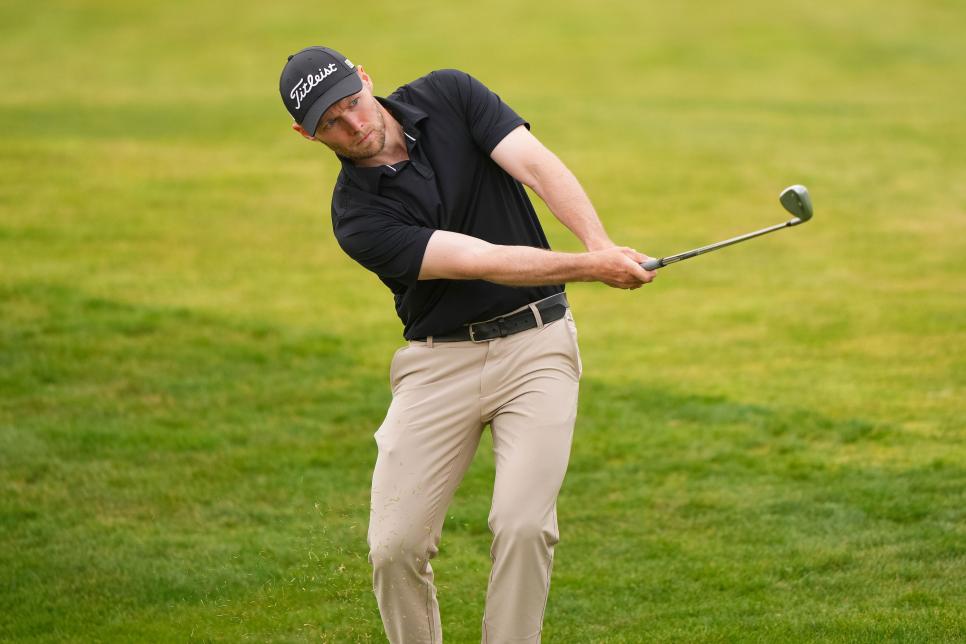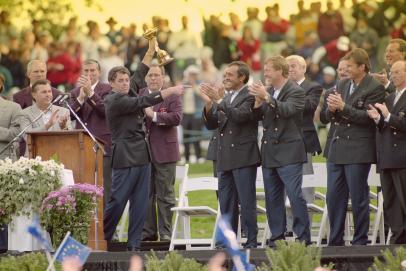Every year, some tourists still arrive in the town of Woodstock, N.Y., hoping to see where the legendary rock 'n roll festival took place in 1969. When they get there, they're disappointed to learn that the “three days of peace and music" that featured 400,000 rain-soaked members of the counterculture generation grooving to the sounds of Santana, Jimi Hendrix and Crosby, Stills and Nash actually took place on a dairy farm 50 miles away, after Woodstock town officials balked at the original plans at the last minute.
What the visitors do see as they drive up the town’s main road, however, is a cute little nine-hole golf course. Built in 1929 on farmland purchased by local businessmen and artists, Woodstock Golf Club takes pride in the fact Gene Sarazen once played a couple of exhibition matches there. But for scratch golfers, it’s hardly an imposing track: It has no practice range, slowish greens, par 4s all less than 360 yards and just one 463-yard “quote-unquote par 5,” as club professional Chris Sanger jokingly describes it.
Yet in a plot line that could be described as a cross between “Finding Woodstock” with “Tin Cup,” Sanger is now headed 200 miles west to Rochester, one of 20 club pros to earn a spot in the upcoming PGA Championship at Oak Hill. Sanger finished T-17 in a field of 320 at the PGA Professional Championship two weeks ago, grabbing the last qualifying spot for the major. It’s a remarkable feat not just because of the tiny size of the club Sanger represents, but the fact the 37-year-old was anything but a world traveler before he flew to the four-day tournament in New Mexico.
“I had never changed time zones,” Sanger says, recalling his first impression of Twin Warriors, the tough desert course where three out of the four rounds were played. “But I felt that I could play the course because it’s pretty open until you get to the desert. If you keep in on the grass, you’re OK.”
Born and raised in the upstate New York town of Red Hook, Sanger first picked up a golf club at 8 and started playing seriously at 14. After competing on his high school team, he took a job washing carts at Red Hook Golf Club and slowly worked his way up to assistant pro. He finally earned his PGA of America certification in 2017 and was hired at Woodstock’s head pro that same year.
Manning a small golf shop and scheduling league and tournament play largely by himself—and with a wife and three children under the age of 7 at home—Sanger doesn’t have much time to play the course. He will sneak out to a small practice green to roll three- to 10-footers and ride around in a cart before sunset. “That’s where I get my swings in and just kind of fiddle around,” he says. “Then when I play, it’s our section events, the Woodstock Open and state opens.”
What Woodstock lacks in practice facilities, though, it makes up in support from its laid-back but golf-crazy membership that numbers about 250. Paying one-time annual dues less than $2,700 and walking the course without caddies, the regulars include school teachers and small business employees, weekenders from Manhattan and Brooklyn, and the odd actor and rock musician. Last summer, after Sanger won one of two spots reserved for pros from the Northeastern New York section to play in the PGA Professional Championship, the Woodstock members raised almost $5,000 in a GoFundMe campaign to pay his way to New Mexico, along with caddie Justin Lane, the son of a town police officer and an aspiring tour pro. (With the Golf Channel covering the tournament in New Mexico, Sanger also received a steady stream of texts from Woodstock members. “They’re going to see this,” he thought to himself. “This is awesome. They’re with me right now. I’m doing this for them.”)
Besides never playing desert golf before getting to Twin Warriors, Sanger had never hit golf balls in the kind of thin air you get at nearly 5,000 feet above sea level. Even after a couple of practice rounds and a nervous but solid day 1 showing of three under, Sanger and Lane were struggling with club selection when, on a par 3, they saw another caddie shoot the pin with a rangefinder and give his player yardages in meters. Puzzled at first, Lane figured out that the percentage difference between a yard and a meter—0.914—was roughly what they needed to correct for the elevation. So for the last two rounds, Lane switched the settings on his own rangefinder and gave Sanger the meter reading as though it was yards.
'My goal going into next week is to be the low club pro. If I can keep the ball in the fairway, I should play well.'—Chris Sanger on playing at Oak Hill

In the third round, the strategy paid off and helped Sanger shoot three under with a hot streak of five birdies in six holes to finish the day tied for third at six under overall. After arriving in New Mexico merely hoping to play four days, he started think about winning the tournament and the $60,000 top prize. An birdie on the first hole of the final round at Twin Warriors, however, accompanied by the pressure and slow play started to get to him, and by the 15th hole he had fallen to two under, in danger of dropping out of the top 20 and missing out on a trip to the PGA.
Sanger finally rallied with a 15-foot birdie putt on the par-5 16th. “Then I kind of knew I just needed four good swings,” he recalls. “I had three of them. I hit a great drive on 18, and then the wind created a little bit of indecision.”
On his second shot, Sanger had 190 yards into what felt like a 25- to 30-mile wind, and hit a 5-iron, but with the elevation it sailed long and right. Needing to land a chip in the rough to stay close to a back right pin, he hit the fringe and the ball rolled 10 feet past the cup. A slippery par putt meandered three feet wide. But just as it had done throughout the first three rounds, all the time practicing short putts in Woodstock paid off. Sander made his bogey and claimed the last qualifying spot for Oak Hill.
Two days later, Sanger was back at work in the Woodstock golf shop, entertaining a nonstop flood of visits, phone calls and texts from excited club members. With one week to prepare for the big show, he planned to drive up to Oak Hill for a practice round while the Woodstock greens were being aerated, then hit balls in his home garage using a launch monitor he bought over the winter. (Other than that, his winter golf this year consisted of two rounds at a nine-hole, par-3 course during a family trip to Florida.)
When Sanger arrives for the PGA Championship, it will be only the second time he has ever experienced a major, after attending a practice round at the 2006 U.S Open at Winged Foot as a spectator. It will also be Lane’s second time at a major, although as luck would have it the first was with his dad to the last PGA at Oak Hill in 2013. “I can picture a lot of things in my head, and I remember certain shots I saw guys hit, but I can’t tell you what hole it was,” Lane says. “Keep in mind, it was 10 years ago, and I was 13.”
Asked if he was hoping to be paired with any tour pros in particular, Sanger says he would enjoy playing with whoever and thinks the exposure will only help his game. And once again, he’s setting his sights high. “My goal going into next week is to be the low club pro,” he says. “If I can keep the ball in the fairway, I should play well.”
A large posse from Woodstock will be there following Sanger and Lane, some proudly wearing hats and shirts emblazoned with the club logo, a dove perched atop a peace sign. Friends from the Northeastern New York section also will be cheering on the first club pro from their ranks to play his way into the PGA Championship.
No matter what happens, it will be a story that Woodstock golfers can savor for decades. For 1969 also holds a special place in town history for another reason: it was the year when the Woodstock Golf Club secured a conservation easement protecting its prized patch of land from ever being sold or used for any other commercial or residential purpose.






